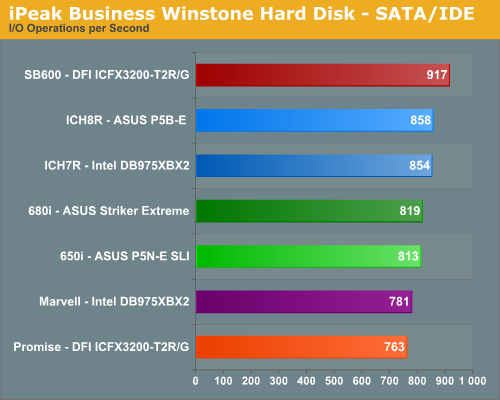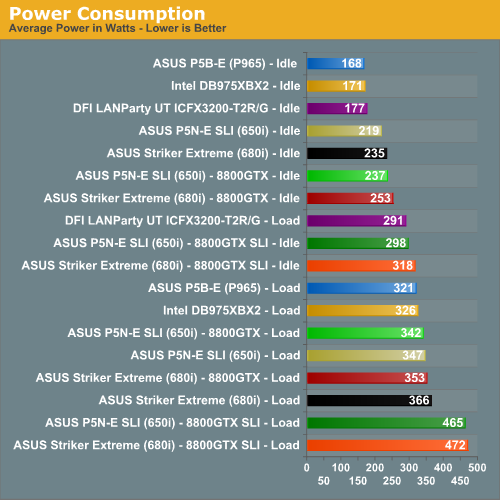ASUS P5N-E SLI: NVIDIA's 650i enters with a Bang
by Gary Key on December 22, 2006 5:00 AM EST- Posted in
- Motherboards
Disk Controller Performance
The AnandTech iPeak test is designed to measure "pure" hard disk controller performance, and in this case we keep the hard drive as consistent as possible while varying the hard drive controller. The idea is to measure the performance of each hard drive controller with the same hard drive.
We played back our raw files that are recorded I/O operations when running a real world benchmark - the entire Winstone 2004 suite. Intel's iPeak utility was then used to play back the trace file of all I/O operations that took place during a single run of Business Winstone 2004 and MCC Winstone 2004. To try to isolate performance differences to the controllers that we are testing we are using the Western Digital 74GB Raptor with 16MB cache for both our standard disk controller and RAID performance tests for this article. The drive is formatted before each test run and a composite average of three tests on each controller interface is tabulated in order to ensure consistency in the benchmark.
iPeak gives a mean service time in milliseconds; in other words, the average time that each drive took to fulfill each I/O operation. In order to make the data more understandable, we report the scores as an average number of I/O operations per second so that higher scores translate into better performance. This number is somewhat meaningless as far as hard disk performance is concerned, as it is just the number of I/O operations completed in a second. However, the scores are useful for comparing "pure" performance of the storage controllers in this case.


The performance patterns hold steady across both Multimedia Content I/O and Business I/O with the SB600 outperforming the Intel ICH7R, Intel ICH8R, and NVIDIA 680i/650i chipsets in our non-RAID tests. The Promise controller on the DFI board is the slowest of all solutions with the Marvell controller on the Intel 975X performing only slightly better. The 680i and 650i MCP units are different but their disk performance in our tests is basically alike. We also ran RAID 0 and RAID 5 tests on each controller with the results being in favor of the 680i MCP by around 2%. We did not witness any data corruption on either ASUS NVIDIA based board as has been reported on the 680i reference boards (though this is apparently now fixed with the latest BIOS updates).
Power Consumption

Our power consumption numbers are based on our test setup for this article that consists of the MSI X1950XT video card. We tested our 650i and P965 based boards with the same setup in our previous tests. We also added results with the 8800 GTX in single card and SLI configurations on the 650 and 680i boards. The 680i leads all boards in power consumption but the 650i SLI is second; on average it consumes about 7% less power than the 680i at idle and 3% less at load. The P965 consumes the least amount of power at idle but around 10% more than the RD600 at load.
The AnandTech iPeak test is designed to measure "pure" hard disk controller performance, and in this case we keep the hard drive as consistent as possible while varying the hard drive controller. The idea is to measure the performance of each hard drive controller with the same hard drive.
We played back our raw files that are recorded I/O operations when running a real world benchmark - the entire Winstone 2004 suite. Intel's iPeak utility was then used to play back the trace file of all I/O operations that took place during a single run of Business Winstone 2004 and MCC Winstone 2004. To try to isolate performance differences to the controllers that we are testing we are using the Western Digital 74GB Raptor with 16MB cache for both our standard disk controller and RAID performance tests for this article. The drive is formatted before each test run and a composite average of three tests on each controller interface is tabulated in order to ensure consistency in the benchmark.
iPeak gives a mean service time in milliseconds; in other words, the average time that each drive took to fulfill each I/O operation. In order to make the data more understandable, we report the scores as an average number of I/O operations per second so that higher scores translate into better performance. This number is somewhat meaningless as far as hard disk performance is concerned, as it is just the number of I/O operations completed in a second. However, the scores are useful for comparing "pure" performance of the storage controllers in this case.


The performance patterns hold steady across both Multimedia Content I/O and Business I/O with the SB600 outperforming the Intel ICH7R, Intel ICH8R, and NVIDIA 680i/650i chipsets in our non-RAID tests. The Promise controller on the DFI board is the slowest of all solutions with the Marvell controller on the Intel 975X performing only slightly better. The 680i and 650i MCP units are different but their disk performance in our tests is basically alike. We also ran RAID 0 and RAID 5 tests on each controller with the results being in favor of the 680i MCP by around 2%. We did not witness any data corruption on either ASUS NVIDIA based board as has been reported on the 680i reference boards (though this is apparently now fixed with the latest BIOS updates).
Power Consumption

Our power consumption numbers are based on our test setup for this article that consists of the MSI X1950XT video card. We tested our 650i and P965 based boards with the same setup in our previous tests. We also added results with the 8800 GTX in single card and SLI configurations on the 650 and 680i boards. The 680i leads all boards in power consumption but the 650i SLI is second; on average it consumes about 7% less power than the 680i at idle and 3% less at load. The P965 consumes the least amount of power at idle but around 10% more than the RD600 at load.










27 Comments
View All Comments
yyrkoon - Friday, December 22, 2006 - link
Yeah, feature wise, its not too bad, too bad Asus has long ruined their reputation with me over the years. Would be just my luck, if I bought this, would make my 7th (in a row) Asus board that was bad out of the box . . .tayhimself - Saturday, December 23, 2006 - link
That suggests that you are the problem, not Asus.yyrkoon - Sunday, December 24, 2006 - link
Might it also suggest that I've been building systems since the 80's, and still don't know what I'm doing ? You, and I both can make random assumptions about each other all day long, but it wont make anything change the fact that each board WAS dead. Period.LoneWolf15 - Tuesday, December 26, 2006 - link
Personally, I think you have just offended the Great Spirits of Technology in some way. ;)cryptonomicon - Friday, December 22, 2006 - link
I like how this board has two firewire ports yet the pricing on the board is still close to the 965 based boards, which don't have them.rallyhard - Friday, December 22, 2006 - link
Thanks for the great article!(One thing I noticed...Page 5, CoH SLI Test...shouldn't that be the P5N-E with the 8800GTX SLI on top in the bar graph?)
JarredWalton - Friday, December 22, 2006 - link
Corrected, thanks, although hopefully it was clear that was SLI. :)